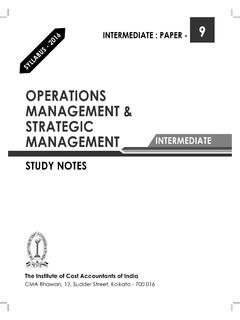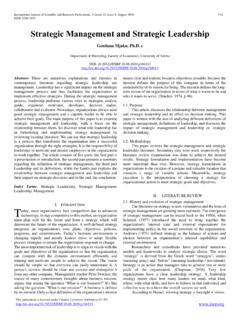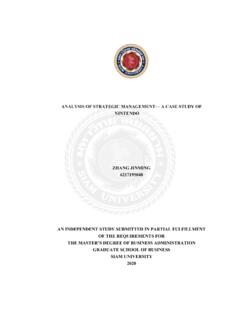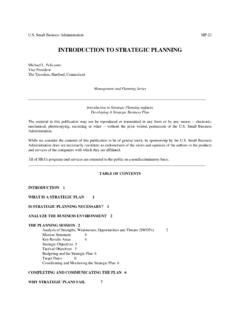Transcription of Strategic Management Process - AABRI
1 Journal of Comprehensive Research, Volume 5, Page 17 Strategic Management Process Strategic Management Process Dr I. Chaneta Department of Business Studies Faculty of Commerce University of Zimbabwe Abstract Wheelen and Hunger (2002) say that Strategic Management is a set of managerial decisions and actions that determines the long-run performance of an organization. It includes environmental scanning (both external and internal) strategy formulation ( Strategic or long- range planning), strategy implementation and evaluation and control. The study of Strategic Management emphasizes the monitoring and evaluation of external opportunities and threats in light of an organization's strengths and weaknesses (Kenneth, 1987).
2 The strategy of an organization consists of the moves and approaches made by Management to produce successful performance of an organization. Strategy is Management s game plan for the business. Management develops strategies to guide how an organization conducts its business and how it will achieve its target objectives. Without a strategy, there is no cohesive action plan to produce the intended results. Core Management functions are crafting and implementing a strategy for the business. Good Management is exhibited by good strategy and good implementation.
3 Powerful execution of a powerful strategy is a proven recipe for business success. The standards for judging whether an organization is well managed are based on good strategy-making combined with good strategy execution. Key Words: environmental scanning, strategy, monitoring, Strategic planning, evaluation, implementation. Journal of Comprehensive Research, Volume 5, Page 18 Strategic Management Process introduction However, strategy-making and strategy-implementation do not guarantee superior organizational performance continuously. Even well managed organization can sometimes hit the skills for short periods because of adverse conditions beyond Management s ability to foresee or react to.
4 It is Management s responsibility to adjust negative conditions by undertaking Strategic defenses and managerial approaches that can overcome adversity. However, the essence of good strategy-making is to build a position strong and flexible enough to provide successful performance despite unforeseeable and unexpected external factors. Five tasks of Strategic Management Figure I 1 2 3 4 5 Defining the business and developing a mission Setting objectives Crafting a strategy to achieve the performance objectives Implementing and executing the strategy Evaluating performance and initiating corrective adjustments Developing a vision and a mission A question senior managers of any firm ask is What is our business and what will it be?
5 This question pushes managers to consider what the organization's business make up should be and to develop a clearer mission of where the organization needs to be headed over the next five- to - ten years. Management s vision of what the organization seeks to do and to become is commonly termed the organization's mission. A mission statement establishes the organization's future course and outlines who we are, what we do and where we are going . This sets out a particular business position. Setting objectives The purpose of setting objectives is to convert the mission statement into specific performance targets.
6 Objectives serve as yardsticks for tracking an organization's performance and progress. The challenge of trying to close the gap between actual and desired performance pushes an organization to be more inventive, to exhibit some urgency in improving both its financial performance and its business position. Setting challenging but achievable objectives helps in guarding against complacency. The objectives set must ideally embrace a time horizon that is both short-term and long-term. Short-term objectives spell out the immediate improvements and outcomes desired by managements.
7 Objective setting is required of all managers. Every unit in the Journal of Comprehensive Research, Volume 5, Page 19 Strategic Management Process organization needs concrete, measurable performance targets, indicating its contribution to the overall organizational objectives. When organization's objectives are broken down into specific targets for each unit, lower-level managers are held accountable for achieving them. A results-oriented climate emerges, with each part of the organization striving to achieve results that will move the whole organization in the internal direction.
8 Two types of performance yardsticks The two performance yardsticks are financial and Strategic objectives: Financial objectives These objectives are needed because acceptable financial performance is critical to preserving an organization's viability and well-being. Financial objectives typically focus on such measures as earnings growth, return on investment and cash flow. Strategic objectives Strategic objectives provide consistent direction in strengthening a company s overall business position. They relate more directly to a company s overall competitive situation and involve such performance yardsticks as growing faster than the industry s average and making gains in market share.
9 Strategic objectives make it explicit that Management not only must deliver good financial performance but also must deliver on strengthening, the organizations long- term business and competitive position. Crafting a strategy What is a strategy? It is the pattern of organizational moves and managerial approaches used to achieve organizational mission. Objectives are the ends and strategy is the means of achieving them. Strategy is a Management tool for achieving Strategic targets. What is important to take note of is forming a strategy that starts with the analysis of the organization's internal and external situation.
10 Armed with an understanding of both environments, managers can better devise a strategy to achieve, targeted Strategic and financial results. An organization's strategy is always a blend of prior moves and approaches already in place and new actions being mapped out. An organization's strategy that is mostly new most of the time, signals erratic decision-making and weak strategizing on the part of the managers (Thompson and Strickland1 1992). Quantum changes in strategy can be expected occasionally, especially in crisis situations but they cannot be made too often without creating undue organizational confusion and disrupting performance.

















